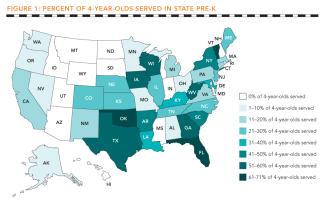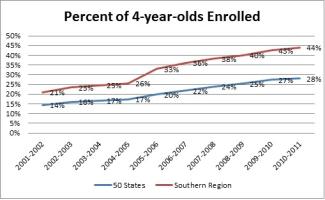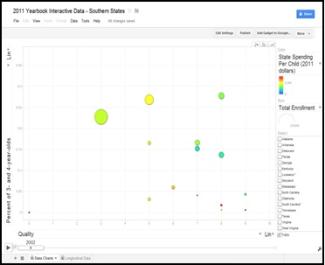
Preschool for Y’All
The Rise of Early Education in the South
November 1, 2012
(PART 1 OF 2-PART SERIES)
As our State of Preschool 2011 report made clear, state-funded pre-K nationwide has fallen victim to tight budgets. As rises in enrollment outstripped funding increases, per-child spending was dragged down. We’ve also seen that disparities in quality, access, and resources have been exacerbated over the last decade, as some states prioritized early education during budget crises while others cut spending. A quick look at regional trends finds one important point: early childhood education is a priority down South.
The South, as defined by the Census Bureau, comprises 16 states* — Alabama, Arkansas, Delaware, Florida, Georgia, Kentucky, Louisiana, Maryland, Mississippi, North Carolina, Oklahoma, South Carolina, Tennessee, Texas, Virginia, and West Virginia. (These states are further subdivided into three smaller regions, as grouped here.) A quick look at our Access map below, demonstrating the percent of 4-year-olds enrolled in each state’s state-funded pre-K program, shows that some of the highest access states are in the South. In fact, 10 of the top 15 states for 4-year-olds are in this region.

Mississippi is the only state in the South without a state-funded pre-K program. Otherwise, the South has prioritized access to state-funded pre-K, as evidenced by data such as:
- All-age pre-K enrollment in this region is more than 700,000 children. This is 54 percent of children enrolled nationwide, though these states account for only one-third of the total U.S. population.
- Most states in this region maintain impressively high enrollment levels, including Florida with the highest enrollment percent in the nation for 4-year-olds at 76 percent.
- Since the 2001-2002 school year, the percent of 4-year-olds in the Southern region has consistently, and significantly, outpaced the 4-year-old enrollment rate across all 50 states, as can be seen below.

A large proportion of both Southern and national enrollment growth was the implementation of Florida’s Universal Prekindergarten Program in the 2005-2006 year, which enrolled more than 100,000 4-year-olds in its first year alone and has continued growing. Enrollment of 4-year-olds has increased nationwide in the last decade due in part to increased advocacy efforts at the state and national levels as well as a growing body of research proving the effectiveness of pre-K. However, the impact of these efforts can be seen even more clearly in the South, where enrollment has increased by a staggering 23 percentage points during the past decade, compared to only 14 percentage points nationwide.
Most Southern states also excel in terms of our Quality Standards Benchmarks.
- Only five states nationwide meet all 10 of these, and three of them are in the South—Alabama, Georgia, and North Carolina. (One of Louisiana’s three state programs also meets all 10).
- Another nine Southern states meet eight or nine benchmarks, an exceptional track record for one region.
- However, the South also has two of the states with the lowest quality standards—Florida meets three and Texas meets four, which is particularly problematic considering their extremely high enrollment levels.
(Click on the Google Motion Chart image below to explore longitudinal changes in access, enrollment, and quality standards in the Southern region.)

Funding per child in the South declined in eight states since the 2001-2002 school year, though both Arkansas and Louisiana posted impressive increases in per-child funding in that time. Only six of these states (Arkansas, Delaware, Kentucky, Maryland, Oklahoma, and West Virginia) met NIEER’s estimate for the per-child spending needed to meet all quality standards benchmarks as well as pay pre-K teachers a salary on par with kindergarten teachers.
Preschool has come a long way in the South, even serving as a national model in many ways, and advocates for children must be vigilant to ensure it serves those children who need it. In our national press release for the Yearbook, we expressed concern than political and financial conditions in Florida, Georgia, North Carolina, and Texas could threaten program progress. (Individual state releases with more information can be found here). Given these threats to programs, it is important to remember this question posted by the Southern Education Foundation in 2010: “This is the South’s challenge and its moment of truth: Do we sustain the one area of public education needed by little children that is successful? Or shall we take steps to reduce or eliminate the best way we have to help little children become ready for success in education for years to come?”
– Megan Carolan, Policy Research Coordinator, NIEER
– Jim Squires, Senior Research Fellow, NIEER
* The District of Columbia is also included in the Census definition of the South, though their enrollment figures are not included here as it would be inconsistent to compare a city among states. However, the District of Columbia has also shown a substantial commitment to early childhood education and provides publicly-funded pre-K to the majority of its 3- and 4-year-olds in a variety of settings.
The Authors
About NIEER
The National Institute for Early Education Research (NIEER) at the Graduate School of Education, Rutgers University, New Brunswick, NJ, conducts and disseminates independent research and analysis to inform early childhood education policy.

